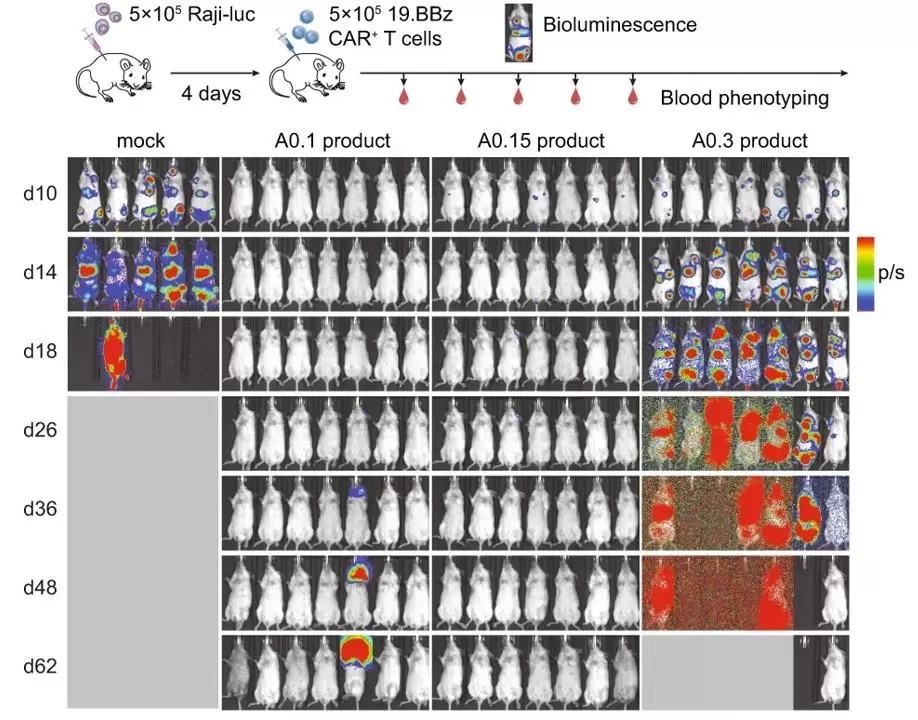CAR-T Target Luciferase-labeled Raji Cancer Cell Line
| Specifications | |
|---|---|
| Cell Category: | Cancer Cells & Cell Lines |
| Organism: | Human |
| Cell Type: | B Lymphocyte |
| Cell Line: | Raji cancer cell line |
| Culture Properties: | Suspension |
| Expressed Gene: | Firefly luciferase |
| Marker: | Puromycin |
| Pathology: | Burkitt’s Lymphoma |
Product Description
- Quantifies the cytotoxicity of CAR-T cells
- Enhances inter-assay reproducibility
- Real-time monitor of the efficacy of candidate CAR-T cells
This luciferase-labelled CAR-T target cancer cell line can be used as a target cancer cell for in vitro killing assays by CAR-T cells. The luciferase-mediated bioluminescence imaging (BLI) assay is one of the most commonly used assays to investigate cell-mediated cytotoxicity. The cytotoxicity of effector cells can be quantified by measuring the decrease in the BLI signal. In addition to the simplicity of the BLI assay, the use of luciferase-labelled target cells enhances inter-assay reproducibility. The utilisation of these stable cell lines in cytotoxicity and cell viability assays facilitates real-time monitoring of the potency and efficacy of candidate CAR-T effector cells, driving breakthroughs in immunotherapy.
Established from tumour cells of a Burkitt’s lymphoma patient, Raji cells constitutively express the B-cell antigens CD19, CD20 and CD22 and can be used to evaluate cancer-targeted immunotherapies such as CAR-T cells.
The luciferase-labelled Raji cancer cell line was modified from the Raji wild-type cell line to stably express firefly luciferase. Raji-Luc cell line did not differ significantly from the wild-type cells in appearance, and trended similarly to the wild-type Raji cell line in terms of tumourigenicity. High expression of luciferase activity was detected in this cell line.
Raji-Luc cell line is an excellent target for CAR-T or NK cells targeting CD19, CD20 or CD22. The luciferase reporter gene produces a signal that is proportional to the number of Raji cells, helping to quantify how well it kills Raji cells when co-cultured with CAR-T or NK cells.
Case Study
The luciferase-labelled Raji cancer cell line naturally expresses high levels of CD19, which can be used as a target cancer cell for in vitro killing assay by CD19 CAR-T cells and is expected to also work for CD20 CAR-T cells. Zhang, D.K.Y. et al. tested the efficacy of three CAR-T cell products using CD19-expressing Raji-luc cells in a disseminated xenograft model of Burkitt’s lymphoma.The level of fluorescence intensity of Raji-luc cells in vivo reflects the proliferation and distribution of tumour cells in the animal.

Ref. Zhang, D.K.Y., Adu-Berchie, K., Iyer, S. et al. Enhancing CAR-T cell functionality in a patient-specific manner. Nat Commun 14, 506 (2023).
Performance Data

Fig.2. Serial dilutions of Raji-Luc cells were plated into a 96‐well plate (white well). The luciferase activity was tested using GeneCopoeia™ Luc-Pair™ Firefly Luciferase HS Assay Kit. High expression of Luciferase activity was detected in this cell line.
Commercial Price Disclaimer
Researchers at for-profit organizations and corporations, please contact us for pricing of this item.
Genetically Modified Organism (GVO)
See General Terms.
- Catalog Number
SL131-GVO-GC - Supplier
GeneCopoeia - Size
- Shipping
Dry Ice

